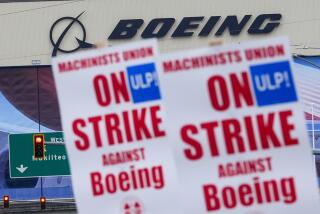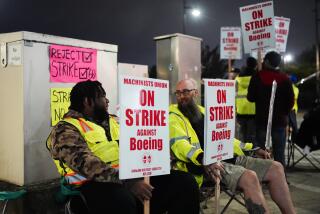U.S. Steel, Union Seem Headed for Bitter Talks
Last week, U.S. Steel Chairman David Roderick got a taste of just how tough this summerâs labor talks are likely to be for the countryâs No. 1 steelmaker.
On June 4, Roderick was visiting Gary, Ind., with Vice President George Bush for what should have been a happy, unifying occasion for both management and labor at U.S. Steelâs huge Gary works. They were there to dedicate a new, modern $300-million casting mill.
But local union leaders in Gary, angry and frustrated over U.S. Steelâs repeated efforts to put the squeeze on labor costs at both the local and national levels, boycotted the ceremony and set up an informational picket line protesting Roderickâs visit.
âThere was no way I was going to go out and beat the drum for U.S. Steel, after the way they have treated us,â said Larry Regan, president of United Steelworkers Local 1015. âYou know what the company did, on top of everything else? They spent money to plant petunias in front of the mill for the ceremony, right after they laid off 150 people. That kind of thing sticks in the craw.â
With contract negotiations between U.S. Steel and the United Steelworkers set to open in Pittsburgh on Thursday, the talk on both sides--in Gary and around the entire U.S. Steel system--is of confrontation, not harmony.
As a result, the company and the union now appear headed on a collision course that could throw both into the biggest labor dispute in the American steel industry in a generation. âThere are certainly reasons to interpret the situation that way,â concedes Steelworkers President Lynn Williams.
So the 22,000 union workers at U.S. Steel, which hasnât suffered a nationwide strike since 1959, are already girding for the worst when the contract expires July 31. âIâve never been on strike, and I donât want to experience it,â says Don Shenefelt, a 39-year-old maintenance man who has worked at U.S. Steelâs Lorain, Ohio, mill for 20 years. âIâve got a wife and three kids to support, and Iâve got to think of them. But I think the company might ask us for too much this year, and might force us on strike.â
This yearâs dispute between U.S. Steel and the union is a simple one. The company wants the same kind of wage and benefit cuts the Steelworkers have granted weaker steel firms in early contract talks over the last few months, and the union doesnât think a relatively stable corporation like U.S. Steel deserves them.
At the plant level, U.S. Steel also wants to combine skilled-trades jobs, reduce work crew sizes, and, in some cases, restrict seniority rights--all in order to reduce employment levels. Those are the kinds of demands that so anger Regan and other local union leaders.
U.S. Steel argues, however, that it needs such concessions in order to remain competitive with the rest of the industry, especially now that its biggest rivals--LTV Corp. and Bethlehem--have already won sizable wage cuts this year, in return for such things as employee profit-sharing and greater job security. While U.S. Steelâs average labor cost (including fringe benefits) remains at $25.20 per hour, the union has allowed troubled LTV to slash its costs to $21.50 an hour, and Bethlehemâs costs have been reduced to $22.49.
âWe have to be cost-competitive with our major competitors, but that is a moving target this year,â says William Hoffman, a U.S. Steel spokesman.
At the same time, cheap imports, which took 22.5% of the U.S. market for finished steel in the first quarter, continue to depress prices and ravage the industry because of the ineffectiveness of the Reagan Administrationâs steel quota program.
So U.S. Steelâs steel operations have been unable to do much better than break even over the last few quarters. Meanwhile, its big energy division has been posting huge losses due to plunging oil prices, so U.S. Steel is increasingly determined to cut costs so that it can post a profit in steel.
Little Sympathy Left
But union officials and rank-and-file workers at U.S. Steel appear to have little sympathy left for the company, and the normally diplomatic Williams concedes that labor-management relations at U.S. Steel are worse now than at many other major steel firms. âThere has certainly been more difficulty in that sense at U.S. Steel than at other firms,â Williams says. Years of concessions, layoffs and corporate diversification into oil and away from steel--topped off by Roderickâs distant and sometimes cold style of dealing with employees--have left workers in no mood to agree to another round of big wage and benefit cuts, local union officials say. And Williams says that he doesnât plan to agree to any.
âAt this moment, there is no consideration of concessions,â says Williams. âItâs our position that U.S. Steel has not established that it is in dire circumstances,â and so doesnât merit the same kind of deal given more troubled firms, he adds.
With the two sides so clearly at odds, the outcome of the negotiations could turn into a test of wills.
But unlike earlier bargaining sessions, U.S. Steel will be all alone this time; the steel industry dissolved its 29-year-old coordinated bargaining council in 1985, allowing each firm to bargain a separate agreement with the union.
Boon to Weaker firms
The breakup of the bargaining council has become a boon for the smaller and weaker steelmakers, because they are no longer locked into paying the same wages as U.S. Steel. In fact, five of U.S. Steelâs major competitors--LTV, Bethlehem, National Steel, Inland Steel and Armco--opened early talks with the union this year in order to get relief before U.S. Steel began its negotiations. Besides LTV and Bethlehem, National has already settled and cut its labor costs by $1.51 per hour, down to $22.21. Negotiations at Inland and Armco are still under way.
The fact that its major rivals have already settled may make U.S. Steel less anxious to take a strike; at a time when its mills would be strike-bound and idle, its competitors would still be operating and ready to steal U.S. Steelâs customers. Thus, the unionâs bargaining position in the U.S. Steel talks would appear to have been strengthened by the councilâs breakup.
âObviously, weâre in a much better position than we would be if everything were up at the same time,â says Williams.
He adds that the union feels its bargaining position is strong enough now to make some demands of its own; Williams will press U.S. Steel to drop its planned joint venture in California with a South Korean steelmaker that could cost thousands of union jobs.
May Eliminate Jobs
In the first such agreement between American and Korean steelmakers, U.S. Steel and Pohang Iron & Steel agreed last year to modernize U.S. Steelâs Pittsburg, Calif., finishing mill located east of San Francisco. It will be used to process semi-finished steel from South Korea. The plan is scheduled to go into effect after the Reagan Administrationâs import quota program expires in 1989, and it is likely to eliminate 2,400 jobs at a U.S. Steel mill in Geneva, Utah, which now supplies the California plant.
Still, top union and company officials stress that they are hopeful that they can avoid a strike. Williams remains optimistic that management will tone down its demands when it comes time to sit down at the bargaining table, and he claims there has already been some subtle movement.
He notes, for instance, that until a few months ago, Roderick was demanding the same steep wage and benefit cuts the Steelworkers gave to bankrupt Wheeling-Pittsburgh Steel in 1985. But now he is only demanding the lesser concessions given LTV and Bethlehem.
âWhere Wheeling-Pitt used to be mentioned, now the talk is only of a competitive agreement,â Williams says. âI think that indicates they are moving in a somewhat more moderate direction.â
More to Read
Inside the business of entertainment
The Wide Shot brings you news, analysis and insights on everything from streaming wars to production â and what it all means for the future.
You may occasionally receive promotional content from the Los Angeles Times.







